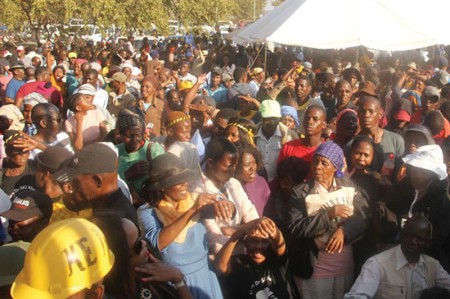How opposition disunity helps BDP
Titus Mbuya | Friday October 18, 2019 12:19


If the opposition contested the 2014 elections as one they would be in power as the nation goes to the polls next week.
This is clearly evident from the margins between the ruling party votes and those of the runners-up in many constituencies around the country. Ordinarily, the strength of a party is presumed to be as good as its performance in the last election.
In the 2014 general elections, out of 57 constituencies there were about 30 around the country with margins of 500 votes or less. Most of these were won by the Botswana Democratic Party (BDP).
It stands to reason that presented with such an opportunity, the opposition would have devised a strategy to work together to wrestle away the marginal seats from the BDP to take over state power in 2019. Of course it is not that easy.
With the realignments that have taken place in the last five years, affecting both the ruling party and the main opposition, Umbrella for Democratic Change (UDC), those margins are just but one factor in a myriad of other dynamics at play.
Even within that mix of variables there are dissimilarities, and commonalities, from constituency to constituency, or specific part of the country under consideration, for that matter.
Indeed, a 500 margin can be wiped off in an instant. But it can also increase exponentially depending on the circumstances on the ground.
As to whether the BDP will be able to defend those marginal constituencies will depend on the numerical strength of the smaller opposition parties participating in the respective constituencies concerned.
Having said that, Takatokwane and Ngami seem out of reach for the BDP. As was the case in 2014 with the Botswana Congress Party (BCP), the smaller parties such as the Alliance for Progressives (AP), Botswana Movement for Democracy (BMD) and, ironically, Botswana Patriotic Front (BPF), are going to spoil UDC’s chance to challenge for state power in these elections. Frankly, there is not much for the smaller parties to play for in this contest except to pull the UDC down.
The BMD is almost nonexistent. Its presence will only be felt in Lobatse and Mochudi West as it deals the UDC another blow.
The new kid in the block, BPF is punching above its weight as the put up candidates in constituencies where UDC is competitive, like Nata-Gweta, Palapye, Mahalapye East and Lobatse, thus splitting the opposition vote even more.
The same party claims that it is cooperating with the UDC to take over state power. This is proof of lack of a well thought-out strategy on their part.
The BPF, a party that has not been tested, has tended to embellish and exaggerate its popularity because of its association with Khama.
Instead of concentrating its resources on fewer constituencies it spread itself thin apparently in an attempt to prove that they are not a tribally based party but one that has national appeal.
The AP, who will also be contesting in a general election for the first time this year, are hanging by a thread. They might lose all the constituencies they inherited from the UDC in the process helping the BDP win such constituencies as Molepolole South, Mogoditshane, Gaborone Bonnington South and Gaborone North.
However, the AP deputy leader, Wynter Mmolotsi is a serious contender in Francistown South. His opponents, UDC candidate, Tiroeaone Ntsima, and Modiri Lucas of the BDP, are greenhorns compared to Mmolotsi who has a track record as an MP who delivers in that constituency. Perhaps the UDC will be the spoiler in this particular instance!
Against the backdrop of the foregoing, the following observations are also germane to next week’s elections.
In past elections, the BDP always had the comfort of having almost 20 safe seats in the bag from the Central District alone even before counting of votes begins. Going into these elections, the BDP runs the risk of losing the bragging rights of the Central District.
The UDC might benefit from the spoils of the breakaway of the BPF from the ruling party. However, the BDP will still be the only party that can lay claim to safe seats – at least 15 of them - spread around the country. Surprisingly, most of the presumed safe seats are in southern Botswana.
This will be at the expense of the UDC whose constituent member, Botswana National Front (BNF) has always been stronger in the south than north.
For the opposition, there is nothing like a safe constituency. It has to “hustle” for each and every seat that is available, even in the urban centres where they enjoy a large following.
In fact, the UDC may not be able to defend at least six constituencies that it won in 2014, and five of those are in the south. They include Molepolole South, Mochudi West, Kanye South, Gaborone Bonnington South, and Gaborone North.
The UDC may, however, be able to compensate for that loss by picking up seats in the central and northern parts of the country.
These include, Ngami, Nkange, Bobonong, Shoshong, Boteti East, Mahalapye and Selibe-Phikwe East.
For the first time the opposition might have more constituencies north of Dibete than ever before. If that happened, then it could very well be surmised that the Masisi/Khama conflict occasioned a shift in the balance of power in terms of party political loyalties in the country.
Only time will tell if that phenomenon can be sustained going forward.
If that happened, the UDC would welcome it as that would affirm it as a real national party with a footprint across all the four corners of the country.
The impact of the smaller parties in these elections should not be measured in terms of how many seats they get, or they don’t get, in Parliament, but in terms of how effective they were in denying the UDC victory.
